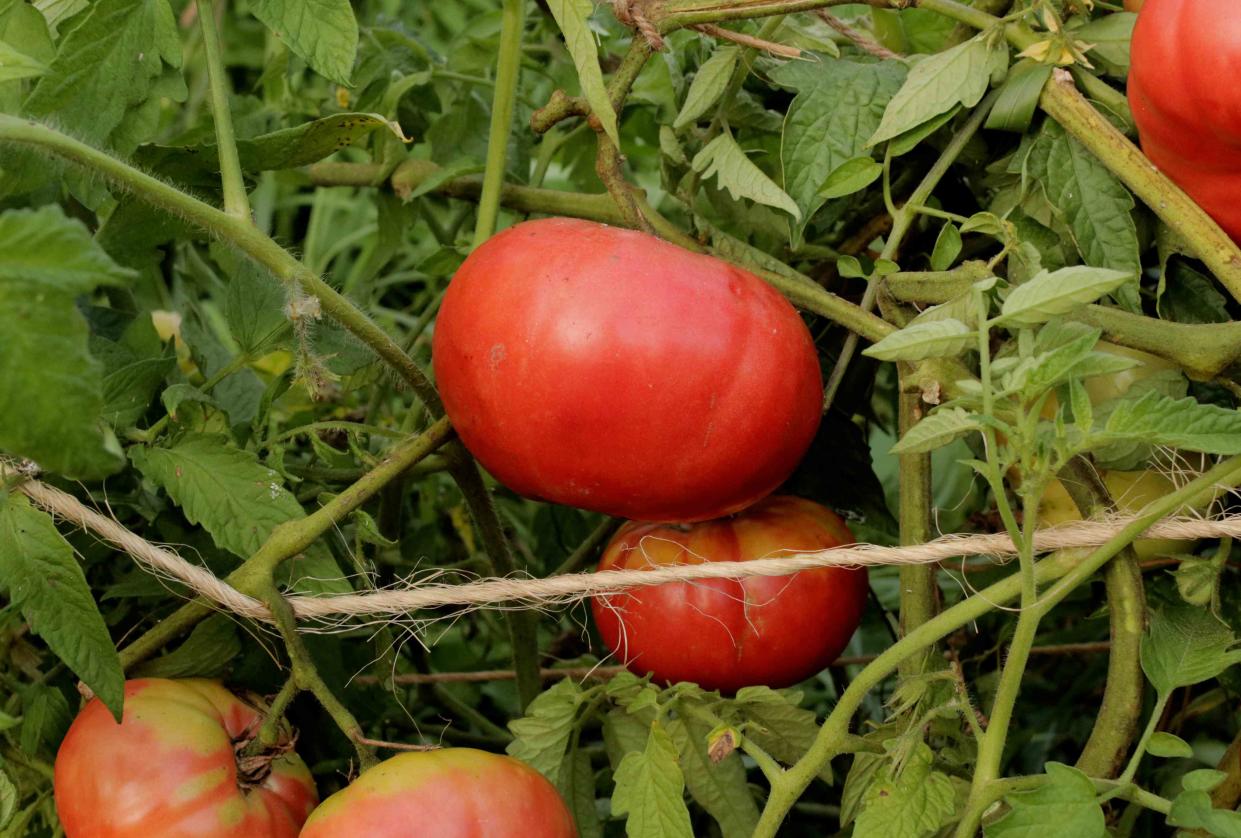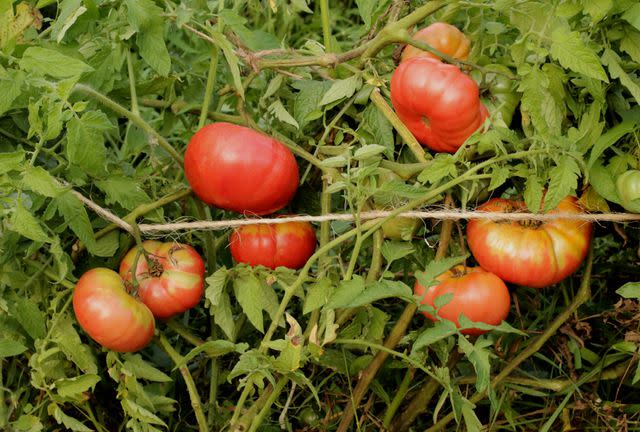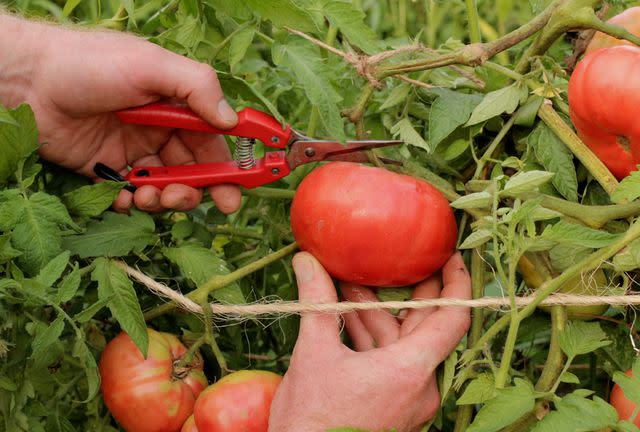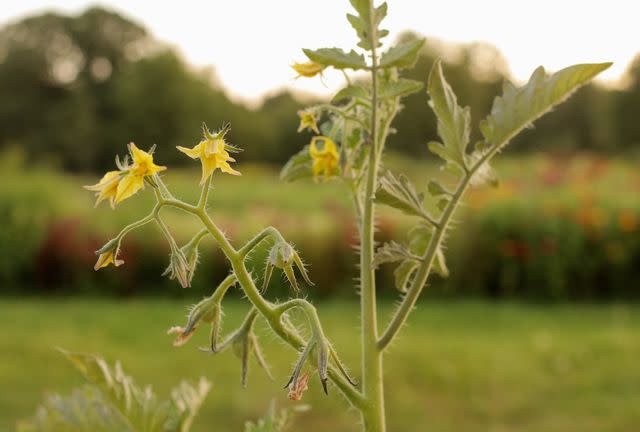How to Grow and Care for Mortgage Lifter Tomatoes

The Spruce / Steven Merkel
Reviewed by Julie Thompson-Adolf
A favorite among tomato varieties, the heirloom Mortgage Lifter tomato is a large, beefsteak fruit. It features smooth, pinkish-red skins, few seeds, and excellent, low-acid flavor in average 1 ½- to 2-pound fruits. In perfect conditions, the fruit can even reach up to 4 pounds. This delicious heirloom, sometimes called Radiator Charlie's Mortgage Lifter for the tomato's breeder, has been around since the 1930s and continues as a best seller for growers and tomato lovers. Tomato plants are toxic to cats, dogs and horses.
Common Name | Mortgage Lifter, Radiator Charlie's Mortgage Lifter |
Botanical Name | Solanum lycopersicum 'Mortgage Lifter' |
Family | Solanaceae |
Plant Type | Annual fruiting vine |
Size | Vines to 9 ft., fruits to 2 1/2 lbs. |
Sun Exposure | Full |
Soil Type | Well-draining loam |
Soil pH | 6.2 to 6.8 |
Bloom Time | Summer |
Hardiness Zones | 2-13 (USDA) |
Native Area | Peru, Ecuador, Bolivia |
Toxicity | Toxic to cats, dogs and horses |
How to Plant Mortgage Lifter Tomato
Tomato plants get off to a better start and yield fruit earlier when the seeds are started indoors 6 to 8 weeks before last expected frost. Hardened off seedlings when several sets of leaves are present before planting in the garden.
When to Plant
Mortgage Lifter tomatoes should be planted outside when soil is warm, at approximately 65 to 70 degrees Fahrenheit, and nighttime temperatures remain above 50 degrees F. In southernmost growing zones, tomatoes can be planted out in autumn or late winter, as long as weather stays warm and sunny. In more temperate zones, plant them outside from mid-April to early June, once all danger of frost has passed.
Selecting a Planting Site
For the biggest, most flavorful yields, plant tomatoes where they receive 6 to 8 hours of sun per day. Choose a location that drains well and avoid garden areas where tomatoes and other nightshades were grown the previous year.
Spacing, Depth and Support
Mortgage Lifter is a big plant capable of producing huge tomatoes. Sturdy supports are necessary. A general guide for placement is 3 feet between plants and 4 feet between rows. A popular method for planting is to dig a deep hole and plant up to 1/3 of the stem. Remove any leaves from the stem portion that will be buried. By planting deeply, additional roots will form along the main stem, helping to create a strong, healthy root system to support the heavy plant.
Another method is to dig a shallow trench, lay the tomato plant on its side, and cover it with soil, leaving the top two sets of leaves exposed. This technique is especially helpful for leggy plants, allowing more roots to form along the stem to create a strong plant.
Mortgage Lifter Plant Care
The big challenge growing Mortgage Lifter is managing the giant, prolific fruits and extremely tall vines. This is one heirloom tomato pretty easy to care for, with above average disease and drought resistance. M.C. Byles (also known as Radiator Charlie), who bred Mortgage Lifter, spent six years cross-breeding his favorite tomato plants to produce a disease-resistant, large, delicious fruit.

The Spruce / Steven Merkel

The Spruce / Steven Merkel

The Spruce / Steven Merkel
Light
Eight hours of sunlight daily is optimal. Plenty of sun is especially important for healthy plants and ripening fruit.
Soil
All tomato plants grow best in rich, loamy soil with a slightly acidic pH of 6.2 to 6.8. Well-draining soil is essential. Avoid planting tomatoes where members of the nightshade family have grown, as diseases and pests may remain in the soil that affect tomatoes. Practice crop rotation for the healthiest garden.
Water
Established tomato plants need 1 inch of water weekly. Drip irrigation works best and helps prevent fungal and leaf spot diseases caused by diseases in the soil splashing on leaves when watered.
The 9 Best Soaker Hoses of 2023
Temperature and Humidity
Temperatures for fruit set and development fall between 65 and 85 degrees F. Above and below this range, plants may fail to produce blooms and flowers may drop without setting fruit. Above 95 degrees F. can result in uneven ripening and flavor. Humidity levels of 65 to 75 percent are sufficient for growing tomatoes.
Fertilizer
Tomatoes, especially large, indeterminate, beefsteak varieties like Mortgage Lifter, are heavy feeders. Adding aged compost to the planting area in autumn or early spring can provide the nutrients your tomato crop needs. Or you can apply a balanced fertilizer with an NPK of 10-10-10 at planting time.
A soil test beforehand will tell you what may be lacking and can determine what, if any, amendments are needed.
Tip
When flowerbuds appear, keep in mind that nitrogen rich fertilizers can accelerate leafy growth at the expense of fruit production. A side dressing of fertilizer slightly higher in phosphorous can support development when fruits are about 1 inch in diameter.
Pollination
Mortgage Lifters are self-fertile, meaning the flowers have both male and female parts. Pollen falls within the flower to pollinate itself. You might see pollinating insects attracted to flowers, however they are not necessary for the plant to produce fruit, although insects and wind aid pollination. One plant is capable of producing 12 to 20 pounds of tomatoes.
Types of Mortgage Lifter
In addition to the classic, reddish pink Mortgage Lifter tomato, a second yellow variety goes by the same name. Another beefsteak type, the yellow Mortgage Lifter produce 1 to 2 pound, slightly flattened fruits with red to pink stripes in the center. The yellow variety yields mild, sweet tomatoes.
Harvesting Mortgage Lifter
You can start to harvest Mortgage Lifter tomatoes around 80 days after transplanting, but some tomatoes may be ready a week or so earlier. Unlike many heirloom varieties that retain green or dark colored hips at the stem end, Mortgage Lifter more often develops a uniform reddish-pink color throughout.
Use a hand pruner or snipper to cut the tomato from the vine leaving about an inch of stem attached to the fruit.
If you have issues with insects snacking on your tomatoes, you can harvest the fruit as soon as it begins to turn color. Place the tomato on a windowsill to allow it to finish ripening.
Tip
Once picked, stems can be carefully removed to avoid piercing other fruits in your basket. Gently and carefully twist and pull the stem out or trim it down with the clipper. Avoid cracking or opening the top of the fruit which can cause it to deteriorate and rot.
How to Grow Mortgage Lifter in Pots
Due to the length of the vines, 9 feet and longer, it is inadvisable to grow Mortgage Lifters in pots.
If you decide to try, fill a minimum 10-gallon container with a good soil and compost mix. Choose one with plenty of drainage holes and room for a sturdy support. Set the plant in a deep hole and be diligent about removing suckers during the first several weeks of growth. Yield will likely be smaller, but patio growers could have success producing several of these large, tasty heirlooms. The soil of potted tomato plants tends to dry out rapidly and may need to watered up to twice daily. Check the top inch of soil with your finger. If it's moist, no need to water. If dry, add water.
Pruning
Indeterminate, vining tomatoes grow rapidly. Heirloom tomato types like Mortgage Lifter will produce an abundance of suckers during early growth. Good air circulation helps prevent disease, so pruning it down to several manageable vines improves overall plant health. Remove suckers during the first several weeks of growth to keep air circulation at a good level.
Vines can also be cut back as the season draws to a close. Use pruners to remove the tip end of the stem back to developing fruit. This directs energy into ripening instead of setting new flowers and fruit.
Propagating Mortgage Lifter Tomato
Tomato plants can be propagated from suckers. This is done by allowing a sucker to grow to about 6 inches long, clipping it from the mother plant at the base, rooting it in water, and planting it in a new location. Since Mortgage Lifter requires 80 days to mature, the more efficient propagation method is to start with seed.
How to Grow Mortgage Lifter Tomato from Seed
You can save seeds from your Mortgage Lifter crop to plant next year. The seeds are reliably long-lasting, so don't throw out those extras still in last year's seed packet.
Seeds can be started six to eight weeks before the last frost in a heated indoor location. You will need a good light source once the seeds sprout. To get started, gather together your seeds, a cell flat or small 3- to 4-inch pots, soil-less seed starting mix, and a plastic dome or bag,
Dampen the seed starter with warm water. The mix should be moist but not soggy.
Fill each cell or pot with planting mix.
Use your index finger to press a slight indentation into the center of each. Plant seeds 1/8 inch deep.
Cover lightly with more soil-less mix and cover the tray or pots with plastic.
Place your starts in a warm location, ideally 70 to 80 degrees F. and keep them moist. A heat mat helps speed germination.
After seeds sprouts (about one week) remove the plastic and relocate the plants to a sunny window or place them under grow lights.
When seedlings have developed two true leaves and can be handled, pot them up into individual pots, if necessary.
Start hardening off a week or so prior to transplanting in the garden.
Tip
Providing bottom heat and watering from the bottom benefit germination. Heat mats are widely available, or try placing your starts on top of the refrigerator. To water from the bottom, place the starts in a solid bottom container filled with enough water to reach the bottom of the pots.
Common Pests and Plant Diseases
Mortgage Lifter has good resistance to wilts. It is vulnerable to a number of other fungal and bacterial problems that affect tomatoes. Starting out with healthy seedlings and good growing conditions can prevent crop loss. Good air circulation and adequate spacing between plants helps prevent diseases.
The pests that most often affect tomatoes are hornworms, army worms, and aphids.
How to Get Mortgage LIfter to Bloom
This variety blooms early and reliably given adequate growing conditions. If blossoms seem insufficient, try a foliar spray of fish emulsion. Add compost tea or apply a fertilizer slightly higher in phosphorous such as a 5-10-5.
Common Problems With Mortgage Lifter
Mortgage Lifter is one of the easiest heirloom varieties to grow. The size of both the plants and the fruits can lead to some common tomato problems.
Tomatoes crack and split
These large tomatoes are vulnerable to cracking and splitting caused by uneven watering. An open fruit is an invitation for pests and disease, so harvest and use cracked tomatoes immediately. Water your plants on a regular schedule, taking into account rainfall. Harvesting a bit early before the fruit is fully ripe can also cut down on splitting and cracking.
Yellow leaves
Leaves closest to the stem and bottom of the plant often turn yellow, dry up, and fall off. This is normal as the plant targets more nutrients to developing fruit.
If leaves develop sunken or discolored spots, you may be dealing with a soil borne disease. Use soaker hoses for drip irrigation and avoid wetting the leaves if you’re watering from above. Keep vines staked and off the ground and remove bottom leaves that touch the soil.
Uneven ripening
When part of the tomato appears fully ripe with a pinkish red color but another part remains green and hard, the fruit is not getting sufficient sun exposure. Avoid this by removing suckers early in the season to keep the plant to 3 to 5 productive vines. This allows for more uniform ripening and better air circulation throughout the plant.
Frequently Asked Questions
Is Mortgage Lifter a good tomato?
Mortgage Lifter is a great tomato, as it is one of the easiest to grow heirloom types that puts out lots of fruits. The large, beefsteak tomatoes have few seeds and a sweet, low-acid flavor. It works well on sandwiches and in salads, salsa and sauces.
How big does a Mortgage Lifter tomato plant get?
Mortgage Lifter vines can grow to 9 feet and longer so be sure to have supports on hand. Fruits average 1 1/2 to 2 pounds.
Are Mortgage Lifter tomatoes hard to grow?
Mortgage Lifter tomatoes are one of the easier heirloom types to grow. It's a great plant to start out with if you want to grow an old-fashioned variety. Mortgage Lifter is resistant to tomato wilts and has some drought resistance.
When should I pick my Mortgage Lifter tomatoes?
Start looking for ripe fruits on a Mortgage Lifter plan around 73 days after planting out in the garden. They have a uniform pinkish-red colored skin with just a slight give when pressed.
Read the original article on The Spruce.

